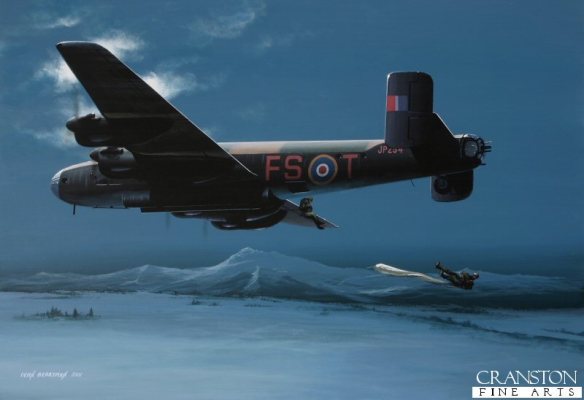
SOE Drop by Ivan Berryman.
Halifax B.II Series 1 (Special) JP254 of 148 Special Duties Squadron, RAF is depicted over the drop zone near to the Alt Aussee salt mine in the Austrian Alps as two of the four SOE agents exit the bomber via the crew access door. Their mission was to secure and protect 6,755 items of the world’s greatest works of art that had been looted and stored by the Germans as they swept across Europe. With the allied forces closing in, the Germans had planned to blow up the entire store to prevent the artworks from falling into the hands of the liberators. Once on the ground, the four agents linked up with local resistance fighters and the mine and its valuable contents were eventually secured, the explosives made safe and the entire cache taken into the safe keeping of the 80th US Infantry Division as the German occupation of Europe crumbled.
So called because these clandestine units usually only flew missions into Nazi-occupied territory at night during the period of the full moon, the Royal Air Force Special Duties squadrons were equipped with Westland Lysander and Lockheed Hudson aircraft. The original Moon Squadron consisted of the four Lysanders of the Special Duties unit, 419 Flight (based initially at North Weald, Essex, and then at Stapleford, Abbots, and Stradishall), which was amalgamated with three Whitley and two Halifax bombers to form 161 Squadron at Tempsford in February 1942 be- fore being disbanded in June 1945.
Meanwhile, 138 (Special Duties) Squadron had been formed at Newmarket in February 1941 and combined with the King’s Flight (419 Flight). In August 1941, 419 Flight became 138 Squadron, with eight Whitleys and two Lysanders, which were replaced with the Halifax in October 1942. Based at Tempsford, the Halifax was replaced with Stirlings in September 1944, and in March 1945 was transferred to Bomber Command and reequipped with Lancasters. All these units acted on behalf of the Secret Intelligence Service (SIS) and Special Operations Executive, and the first such mission of World War II was the dropping into France in October 1940 by the 419 Flight Whitley of a SIS agent, Philip Schneidau, who was collected from Montigny 10 days later by a Lysander from Stradishall, via Tangmere, flown by Wally Farley.
In the Mediterranean theater, 267 Squadron, equipped with Dakotas, was transferred from Heliopolis in Egypt to Bari in Italy to perform Special Duties in the Balkans. In February 1945, the squadron was posted to Burma, but flew regular transport missions. In September 1943, 1575 Special Duties Flight at Blida, Algeria, was redesignated as 624 Squadron and flew clandestine missions to France, Italy, Czechoslovakia, and the Balkans until it was disbanded in September 1944. Also flying into Poland from the Mediterranean was 1586 Flight, staffed with Polish personnel. It was redesignated as 301 Squadron in November 1944, to fly missions over the Balkans, and was disbanded in December 1946.
In the Far East 240 Squadron (based at Redhills Lake, Madras, and equipped with Catalinas) flew Special Duties flights from April 1943, landing agents on the Burmese coast. Missions to Malaya and the Dutch East Indies followed, and the squadron was disbanded in July 1945. Also at Redhills Lake were three Catalinas of 357 Squadron, previously formed at Digri in February 1944 from 1576 (Special Duties) Squadron with seven Hudsons and three Liberators. The 357 Squadron was disbanded in November 1945. The 628 Squadron, at Redhills Lake from March 1944, infiltrated Force 136 personnel into Burma and Malaya with Catalinas until it was disbanded in October the same year. The 1576 Flight (formed at Chaklala, India, in June 1943) flew flights over Burma, using a forward base at Dum Dum, Calcutta, and was disbanded in February 1944.
In January 1945, 358 Squadron had a brief existence at Digri with 16 Liberators, dropping supplies across southeast Asia until it too was disbanded in November 1945.
The Moon Squadrons relied on four main aircraft, with the slow but sturdy Lysander, with a range of 800 miles, proving the most reliable for pickup operations, capable of carrying up to four passengers. Also popular were the long-range B-24 Liberator and the PBY-1 Catalina flying boat for amphibious operations. The Whitley, which was obsolete at the outbreak of war, with a range of 1,500 miles, was used to drop agents into Nazi-occupied Europe until late in 1942, when it was replaced by the Halifax with a range of 1,860 miles.